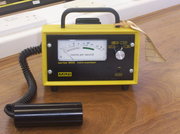Geiger counter

A Geiger counter measures ionizing radiation. Geiger counters can detect photons, alpha, beta, and gamma radiation, but not neutrons. The sensor is a Geiger-Müller tube, a gas-filled tube that briefly conducts electricity when a particle or photon of radiation briefly makes the gas conductive. The instrument amplifies this signal and displays it to the user, either as a current measurement (needle, lamp) or an audible click (one click for each single particle).
Hans Geiger developed the Geiger counter in 1908 together with Ernest Rutherford. This counter was only capable of detecting alpha particles. In 1928 Geiger and Walther Müller (a PhD student of Geiger) improved the counter so that it could detect all kinds of ionizing radiation. The current version of the Geiger counter is called the halogen counter. It was invented in 1947 by Sidney H. Liebson (Phys. Rev. 72, 602–608 (1947)). It has superseded the Geiger counter because of its much longer life and lower operating voltage.
The Geiger-Müller tube is one form of a class of radiation detectors called gaseous detectors or simply gas detectors. Although useful, cheap and robust, a counter using a GM tube can only detect the presence and intensity of radiation.
The Geiger-Müller counter has applications in the fields of Nuclear Physics, Geophysics (Mining) and medical therapy with isotopes.
Gas detectors with the ability (due to their construction, gas filling, and associated electronics) to both detect radiation and determine particle energy levels are called proportional counters. Some proportional counters can detect the position and/or angle of the incident radiation as well. Some of these have many internal wires and electrodes and are called multi-wire proportional counters or simply MWPCs, and have been used extensively in nuclear physics/medicine, particle physics, astronomy and in industry.
Other devices detecting radiation include: ionisation detectors dosimeters, photomultiplier, semiconductor diode detectors and variants including CCDs, microchannel plates, scintillation counters, solid-state track detectors, cloud chambers, bubble chambers, spark chambers, neutron detectors and microcalorimeters.
See also
General
- Timeline of invention
- Measuring instrument
- Hardware random number generator
- Civil Defense Geiger Counters
